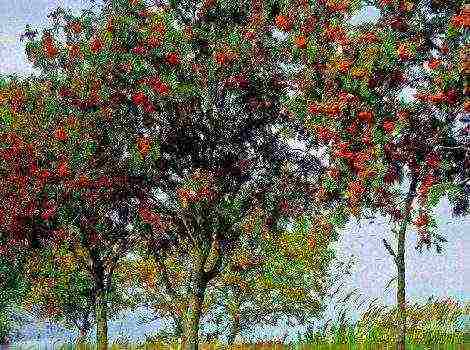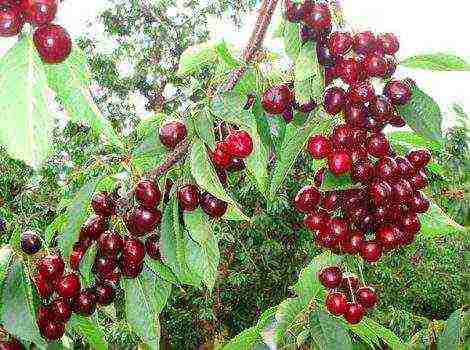Content [show]
Detailed description of the cherry plum variety Kuban comet
There are many varieties of cherry plum in the world, which differ in size and number of fruits, ripening period, as well as a number of other qualities. One of the best among them is the Kuban comet cherry plum variety,the description of which can be found below.
The history of selection of cherry plum Kuban comet
The Kuban comet variety was bred by G.V. Eremina and S.N. Zabrodina at the Crimean experimental selection station of the All-Russian Research Institute of Plant Industry named after N.I. Vavilov. It was born thanks to the crossing of Skoroplodnaya plum and cherry plum Pionerka... First, in 1977, this variety was taken for state trials. And after 10 years it was entered into the State Register for the North-West, Central Black Earth, North Caucasus and Lower Volga regions.
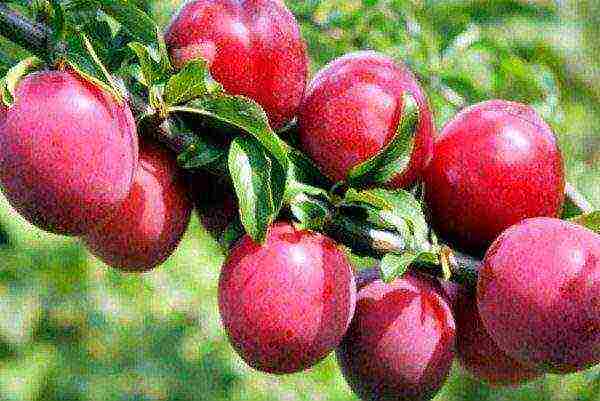
Characteristics of the tree and fruits, description of the variety, pollinator
Trees of this variety are undersized, as a rule, they are not taller than 3 meters and they are shaped so that they look like a shrub. The trees are gray in color and short branches. The green leaves are glossy and not pubescent. Flower buds can be small to medium in size with white petals.
The fruits are large in size. Their maximum weight is about 45 grams... They are round-ovoid. The peel on the fruit, although thin, but dense, also has a slight waxy coating. When the fruits begin to ripen, they first become yellow-red in color, which gradually turns into burgundy. The seeds can be small or medium. The pulp is yellow in color and has a fibrous consistency. It is juicy, with a good ratio of sugar and acidity, due to which it has a sour-sweet taste that resembles an apricot.
The variety of this tree is frost-resistant, can withstand frosts up to 30 degrees... But the frost resistance of flower buds is below average, but even when they are very cold, the harvest will still be good. The flowers also survive spring frosts easily.
This tree is especially undemanding to the soil and can perfectly adapt in different regions from the Transcaucasus to the Non-Black Earth Region and the Southern Urals, South, Primorye. But still, clay and loamy soils are not quite suitable for her.
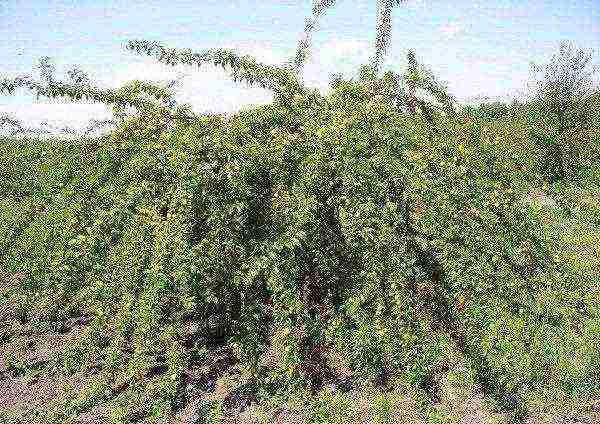
The pollinator for the Kuban comet is not needed, since this variety has a quality of self-fertility, which is rare for cherry plum, but in order to improve fertility next to them, it will be useful to plant other varieties of cherry plum or Chinese plum. For example, such as Mara, Traveler, Red ball and others.
Ripening and harvesting terms
Saplings bear fruit very early, after 2 or 3 years after disembarkation... They begin to bloom at the end of April, and in mid-July - early August, fruits already appear.
Advantages and disadvantages
The Kuban comet variety has its advantages, here are some of them:
- large fruits,
- high yield,
- early maturity,
- frost resistance,
- partial self-fertility,
- resistant to disease,
- if the fruits overripe, they still do not fall off for a long time and do not crack,
- the fruits are delicious.
But the variety is not perfect, it also has its drawbacks:
- the bone is very poorly separated from the pulp,
- to ensure the large size of the fruits, they need to be cut off, leaving them more space, next to each other,
- fruits ripen unevenly.
Landing rules
Trees of this variety are planted in early spring or early autumn.... First you need to choose the right seedlings. It is best to choose them with a closed root system.

A good seedling has the following characteristics:
- height from 1 to 1.20 meters,
- the root consists of many small roots with good branching,
- there are swollen kidneys,
- the bark should be free from damage, stains and traces of pests,
- it is necessary that the cut was wet, yellow-green in color.
When a seedling is selected, it is determined with the planting site.
Alycha will like sandy and slightly acidic soil. It would be wise to mix the planting soil with humus (12 kg), superphosphate (250 grams) and potassium sulfide (50 grams). The planting hole must be dug in size 80x80x80 cm.
Planting stages:
- A little bit of earth is poured into the hole in the form of a small hill.
- Insert a wooden stick.
- The root collar is placed 6 cm higher from the ground.
- They are ramming the ground.
- The seedling is tied to an established stick.
- Sprinkle with 2 or 3 buckets of water.
- At the end, chips are poured on top.
In the case of planting several trees, you need to adhere to a three-meter distance between them.
Care of the Kuban comet
This variety is very fond of moisture, therefore it must be additionally watered during the growing season. They do this in June, July and September. One tree requires up to 40 liters of water. After watering, be sure to add shavings.
The main pruning is done in the spring.... During this period, the crown is formed and the frozen and damaged branches are cut off. In the autumn, dry, sagging and diseased branches are cut down. Summer pruning is carried out if necessary, while cutting off young shoots that grow inside the crown.

The Kuban comet must be fertilized annually... An exception is only the first year after planting a tree, if it was planted in nourished soil.
Fertilization takes place as follows:
- in the fall pour humus at the rate of half a bucket per 1 square meter,
- after the tree has faded, make 40 grams of urea per 1 square meter,
- after fruiting fertilized with potassium sulfate, 30 grams per 1 square meter.
A young tree, in the first years of its life, must be covered for the winter, for example, with burlap.
Diseases and pests
The Kuban comet is resistant to diseases and if it is properly looked after and treated on time, then there will be no trouble. The problem is that pests and diseases from neighboring trees move to it. This variety affects the same types of diseases as ordinary plums.:
- gray rot,
- brown spot
- rust,
- gum flow.
Gray rot
Gray rot is caused by the botrytis mushroom. The birthplace of infection is sclerotia and conidia, which are located in the soil and plant debris.... In the case when the disease affects the Kuban comet, the branches begin to wither and a brown tint appears on them, and small gray growths appear on the bark and fruits.The fruits start to rot.
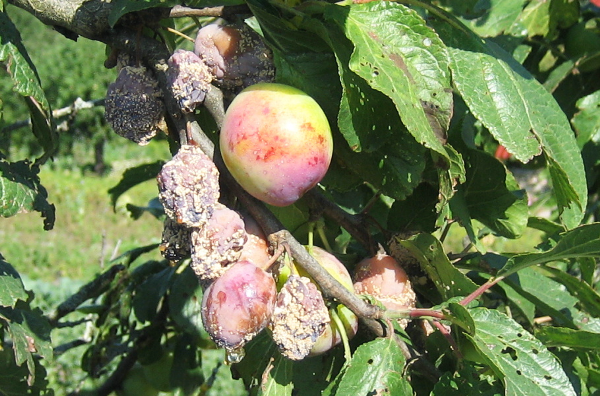
To destroy gray rot, trees are sprayed with copper sulfate and Nitrofen before flowering, which need to be treated with wood and soil. And also after flowering, Kaptan and Kuprozan are used.
To prevent the disease, trees should be sprayed with such preparations in early spring:
- 1% burgundy liquid
- manual bur for affected fruits,
- whitewash.
Brown spot
Brown spot, or it is also called leaf mold, is also a fungal disease. Sometimes because of her, about 50% harvest... This disease is characterized by the appearance on the leaves of brown spots with a dark border, which have a black dot in the center. Over time, the leaves dry out and fall off.
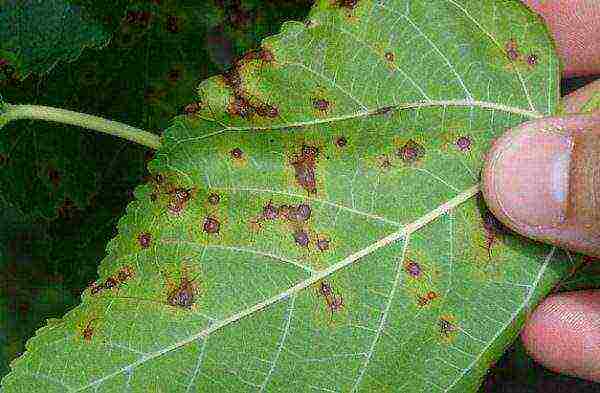
Trees against brown mold need to be treated 1% burgundy solution as soon as the buds begin to bloom and with copper chloride 2 or 3 weeks after flowering.
Preventive actions that will help prevent illness are as follows:
- you need to remove damaged branches,
- before the buds bloom, you need to spray the tree and soil with 1% copper sulfate.
Rust
Another type of fungal disease is rust. In this disease, rusty spots appear on the leaves, which eventually turn into dark pads.... The tree is treated against rust in the second decade of July. You can use Aktofit. The trees are sprayed with it 2 times with an interval of 2-3 weeks.
To prevent rust from attacking the Kuban comet, preventive measures must be taken:
- 3% urea solution is sprayed on the tree in early spring,
- when the leaves fall, it is raked up and burned.
Gum therapy
It is dangerous because it can slow down or stop the growth of a tree, and over time even destroy it.

Gum therapy is not a fungal disease. There can be a lot of reasons for its occurrence. Here are the most common ones.:
- difficult winter conditions, because of which the tree froze,
- burns received from the sun,
- incorrect pruning, due to which the tree was damaged,
- mechanical bark damage,
- oversized fertilization and watering,
- tree infestation bark beetle.
When you examine a tree, you can see gum (protrusions of amber resin) on its branches, this indicates that the tree is affected by this disease. You can treat the Kuban comet from this disease throughout the season.... After trimming, it is imperative to apply petrolatum to the sections. And also cut off the growths of gum. The place where they were is disinfected with a 1% solution of copper sulfate and covered with Negrol putty.
So that you do not have to deal with gum flow for a long time, you need to take such preventive measures:
- the acidity of the soil should be neutral,
- strict adherence to the timing of fertilization,
- avoid waterlogging.
Among the pests that like to profit from the Kuban comet, the most common:
- fruit sapwood,
- western unpaired bark beetle,
- downy silkworm,
- moth.
Fruit sapwood
In the case when there is gum flow on the tree, and horizontal passages with a diameter of 1 to 2 millimeters are visible on the branches and trunk, it means that the sapwood has settled on the tree.
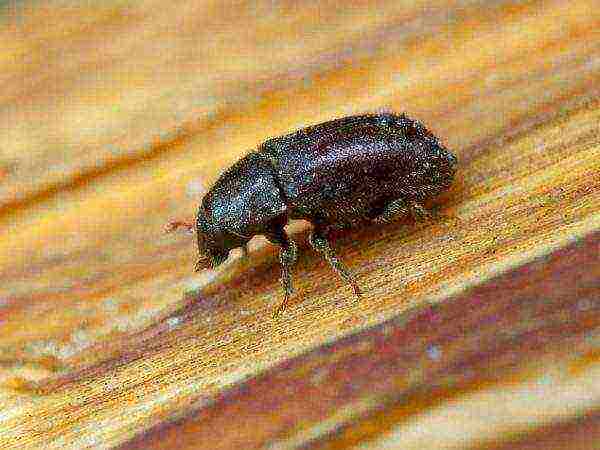
Before the egg-laying period, the females eat the tissues at the base of the kidneys. When the larvae appear, they consume the bark and roots. To destroy these pests, the tree is sprayed at the end of flowering.... The treatment is carried out 2 times with an interval of 14 days.
So that the fruit sapwood does not fall on the tree, you need to saw off dry branches and immediately burn themb. The bark is cleaned of moss and lichen, and the tree is whitewashed.
Western unpaired bark beetle
Do not mind eating the bark, as well as the wood of this tree and the western unpaired bark beetle. Beetles lay eggs and larvae, and when they hatch, they suck the juices from the tree. It is necessary to process the tree when the pests creep out from under the bark. To kill them, it is best to moisten the bark with Dichlorvos or Chlorophos.
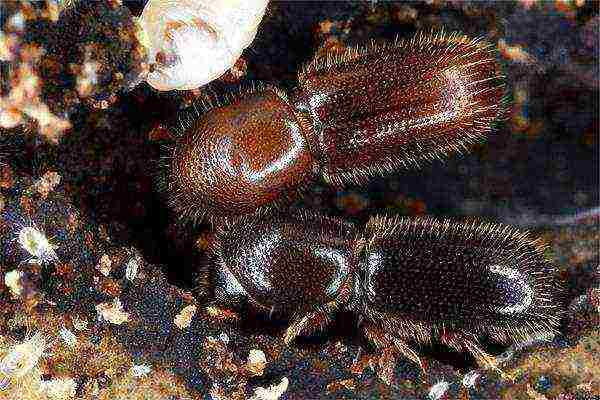
Preventive measures against the appearance of these insects are as follows:
- the affected branches are cut down and burned,
- if the tree is severely affected by this pest, it is better to uproot and burn it,
- before the tree begins to bloom, it must be treated with Trichlorol-5.
Down silkworm
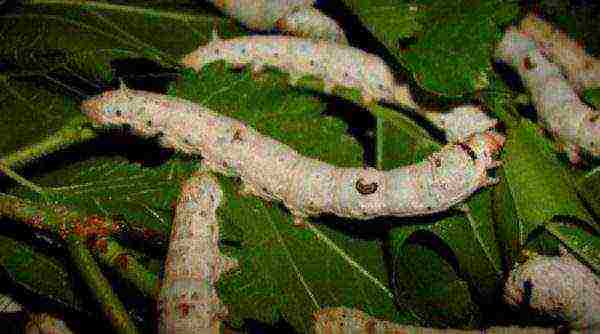
It harms the leaves of the Kuban comet, and its cobwebs and cocoons can be found in the crowns. Spray the tree from this pest during the growing season. The drug Virin-ENZH will help with this. And also you need to collect the pest and cocoons by hand, after which they are burned or buried in a hole, not less than half a meter deep.
To prevent the appearance of a down silkworm, you need spray it with Nitrofen even before the buds appear.
Moth
Another dangerous pest is the moth, which lays eggs on the surface of the bark or fruit. The caterpillars of this insect make their way into the fruit, they become wormy and fall off. You need to process a tree from a moth through 20 days after it fades... Spraying is carried out 3 times with an interval of 12 days, with preparations such as Avant, Rogor-S, Fosban and Ditox.
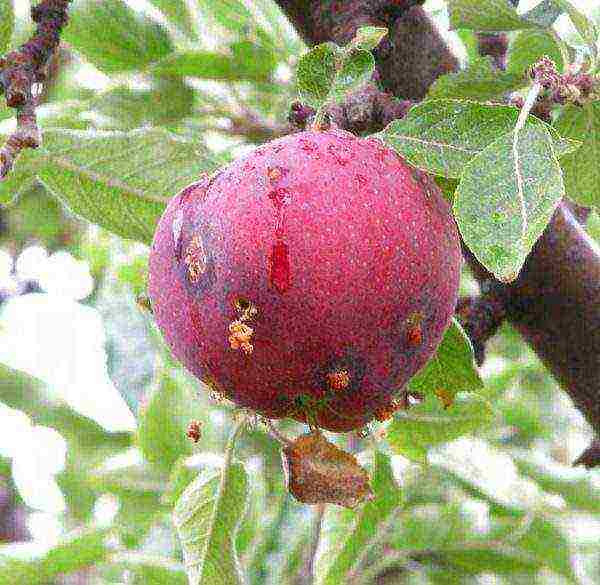
To prevent further reproduction of the moth, in the fall, they clean the bark of caterpillars and cocoons, collect fallen fruits, and also use trapping belts.
If you properly care for the Kuban comet, then the tree will definitely bring a good harvest and grow healthy and beautiful, and the whole family can enjoy its delicious fruits.
